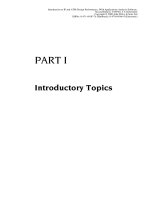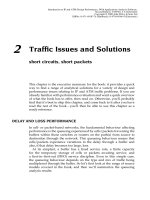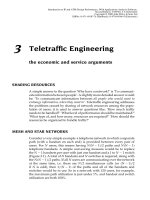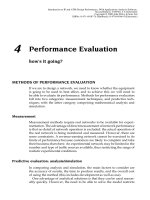Tài liệu Giới thiệu về IP và ATM - Thiết kế và hiệu suất P5 pdf
Bạn đang xem bản rút gọn của tài liệu. Xem và tải ngay bản đầy đủ của tài liệu tại đây (96.31 KB, 12 trang )
5
Fundamentals of Simulation
those vital statistics
DISCRETE TIME SIMULATION
This chapter is intended as an introduction to simulation and, in particular,
its application to cell- and packet-based queueing. For anyone wanting
a more comprehensive treatment of the subject of simulation in general,
we refer to [5.1].
We will introduce the subject of simulation by concentrating on a
discrete version of the M/D/1 queue, applicable to the study of ATM cell
buffering. There are two basic ways to simulate such a queue:
ž discrete time advance
ž discrete event advance
In the former, the simulator moves from time instant i to time instant
i C 1 regardless of whether the system state has changed, e.g. if the
M/D/1 queue is empty at i it could still be empty at i C 1andthe
program will still only advance the clock to time i C 1. These instants
can correspond to cell slots in ATM. In discrete-event simulation, the
simulator clock is advanced to the next time for which there is a change
in the state of the simulation model, e.g. a cell arrival or departure at the
M/D/1 queue.
So we have a choice: discrete time advance or discrete event advance.
The latter can run more quickly because it will cut out the slot-to-
slot transitions when the queue is empty, but the former is easier
to understand in the context of ATM because it is simpler to imple-
ment and it models the cell buffer from the point of view of the
server process, i.e. the ‘conveyor belt’ of cell slots (see Figure 1.4).
We will concentrate on the discrete time advance mechanism in this
introduction.
Introduction to IP and ATM Design Performance: With Applications Analysis Software,
Second Edition. J M Pitts, J A Schormans
Copyright © 2000 John Wiley & Sons Ltd
ISBNs: 0-471-49187-X (Hardback); 0-470-84166-4 (Electronic)
70
FUNDAMENTALS OF SIMULATION
In the case of the synchronized M/D/1 queue the obvious events
between which the simulator can jump are the end of time slot instants,
and so the simulator needs to model the following algorithm:
K
i
D max0, K
i1
C A
i
1
where
K
i
= number of cells in modelled system at end of time slot i
A
i
= number of cells arriving to the system during time slot i
This algorithm can be expressed as a simulation program in the following
pseudocode:
BEGIN
initialize variables
i, A, K, arrival rate, time slot limit, histogram[]
WHILE (i < time slot limit)
generate new arrivals
A := Poisson(arrival rate)
K := K + A
serve a waiting cell
IF K > 0 THEN
K := K —1
ELSE
K := 0
store results
histogram[K] := histogram[K]+1
advance time to next time slot
i := i +1
END WHILE
END
The main program loop implements the discrete time advance mechanism
in the form of a loop counter, i. The beginning of the loop corresponds
to the start of time slot i, and the first section ‘generate new arrivals’ calls
function ‘Poisson’ which returns a random non-negative integer for the
number of cell arrivals during this current time slot. We model the queue
with an arrivals-first buffer management strategy, so the service instants
occur at the end of the time slot after any arrivals. This is dealt with by
the second section, ‘serve a waiting cell’, which decrements the queue state
variable K, if it is greater than 0, i.e. if the queue is not empty. At this
point, in ‘store results’ we record the state of the queue in a histogram. This
is simply a count of the number of times the queue is in state K,foreach
possible value of K, (see Figure 5.1), and can be converted to an estimate
of the state probability distribution by dividing each value in the array
‘histogram[]’ by the total number of time slots in the simulation run.
DISCRETE TIME SIMULATION
71
0510
10
0
10
1
10
2
Histogram(K)
queue state, K
Figure 5.1. An Example of a Histogram of the Queue State (for a Simulation Run of
1000 Time Slots)
Generating random numbers
The function ‘Poisson’ generates a random non-negative integer number
of cell arrivals according to a Poisson distribution with a particular
arrival rate. This is achieved in two parts: generate random numbers that
are uniformly distributed over the range 0 to 1; convert these random
numbers to be Poisson-distributed. Let’s assume that we have a func-
tion ‘generate random number’ which implements the first part. The
following pseudocode converts the random numbers from having a
uniform distribution to having a Poisson distribution.
FUNCTION X = Poisson(arrival rate)
initialize variables
a := e
—arrival rate
b := 1
j := —1
REPEAT
j := j +1
U := generate random number
b := b Ð U
UNTIL b < a
return result
X := j
END FUNCTION
The REPEAT loop corresponds to the ‘generation’ of cells, and the loop
records the number of cells in the batch in variable j, returning the
final total in variable X. Remember that with this particular simulation
program we are not interested in the arrival time of each cell within the
slot, but in the number of arrivals during a slot.
72
FUNDAMENTALS OF SIMULATION
But how do we generate the random numbers themselves? A good
random number generator (RNG) should produce a sequence of numbers
which are uniformly distributed on the range [0, 1] and which do
not exhibit any correlation between the generated numbers. It must
be fast and avoid the need for much storage. An important prop-
erty of the random number sequence is that it must be reproducible;
this aids debugging, and can be used to increase the precision of the
results.
A typical RNG is of the form:
U
i
D a Ð U
i1
C c modm
where U
i
is the ith random number generated, and m (the modulus), a
(the multiplier) and c (the increment) are all non-negative integers, as is
U
0
, the initial value which is called the ‘seed’. The values should satisfy
0 < m, a < m, c < m and U
0
< m.Inpracticem is chosen to be very large,
say 10
9
.
Obviously, once the RNG produces a value for U
i
which it has
produced before, the sequence of numbers being generated will repeat,
and unwanted correlations will begin to appear in the simulator results.
An important characteristic of an RNG is the length of the sequence
before it repeats; this is called the ‘period’. The values of m and c are
chosen, in part, to maximize this period. The Wichmann–Hill algorithm
combines three of these basic generators to produce a random number
generator which exhibits exceptional performance. The pseudocode for
this algorithm is:
FUNCTION U = generate random number
x := 171 Ð x mod30269
y := 172 Ð y mod30307
z := 170 Ð z mod30323
U := x/30269 + y/30307 + z/30323
temp := truncU
U := U — temp
END FUNCTION
The period is of particular relevance for ATM traffic studies, where rare
events can occur with probabilities as low as 10
10
(e.g. lost cells). Once
an RNG repeats its sequence, unwanted correlations will begin to appear
in the results, depending on how the random number sequence has been
applied. In our discrete time advance simulation, we are simulating time
slot by time slot, where each time slot can have 0 or more cell arrivals.
The RNG is called once per time slot, and then once for each cell arrival
DISCRETE TIME SIMULATION
73
during the time slot. With the discrete event advance approach, a cell-
by-cell simulator would call the RNG once per cell arrival to generate the
inter-arrival time to the next cell.
The Wichmann–Hill algorithm has a period of about 7 ð 10
12
.Thus,
so long as the number of units simulated does not exceed the period
of 7 ð 10
12
, this RNG algorithm can be applied. The computing time
required to simulate this number of cells is impractical anyway, so we can
be confident that this RNG algorithm will not introduce correlation due
to repetition of the random number sequence. Note that the period of the
Wichmann–Hill algorithm is significantly better than many of the random
number generators that are supplied in general-purpose programming
languages. So, check carefully before you use a built-in RNG.
Note that there are other ways in which correlations can appear in a
sequence of random numbers. For more details, see [5.1].
M/D/1 queue simulator in Mathcad
The following Mathcad code implements the discrete time advance
simulator pseudocode for the M/D/1 queue. Note that the WHILE loop
in the main pseudocode is vectorized (using range variable i), as is the
REPEAT loop in the Poisson function pseudocode (using range variable j).
An example of the histogram of queue state results is shown in Figure 5.1
(plotting
histogramK
against
Kbins
).
initialize variables
time slotlimit := 1000
arrivalrate := 0 . 5
i := 1 .. time slotlimit
maxK :D 10
K
0
:D 0
generate new arrivals
a:D e
arrivalrate
b
i , 0
:D 1
j:D 1 .. 10
b
i , j
:D
!
rnd 1 Ð b
i , j1
cells
i , j
:D ifb
i , j
< a , 0 , 1
A
i
:D
j
cells
i , j
serve a waiting cell
K
i
:D max[[0 K
i1
C A
i
1]]









